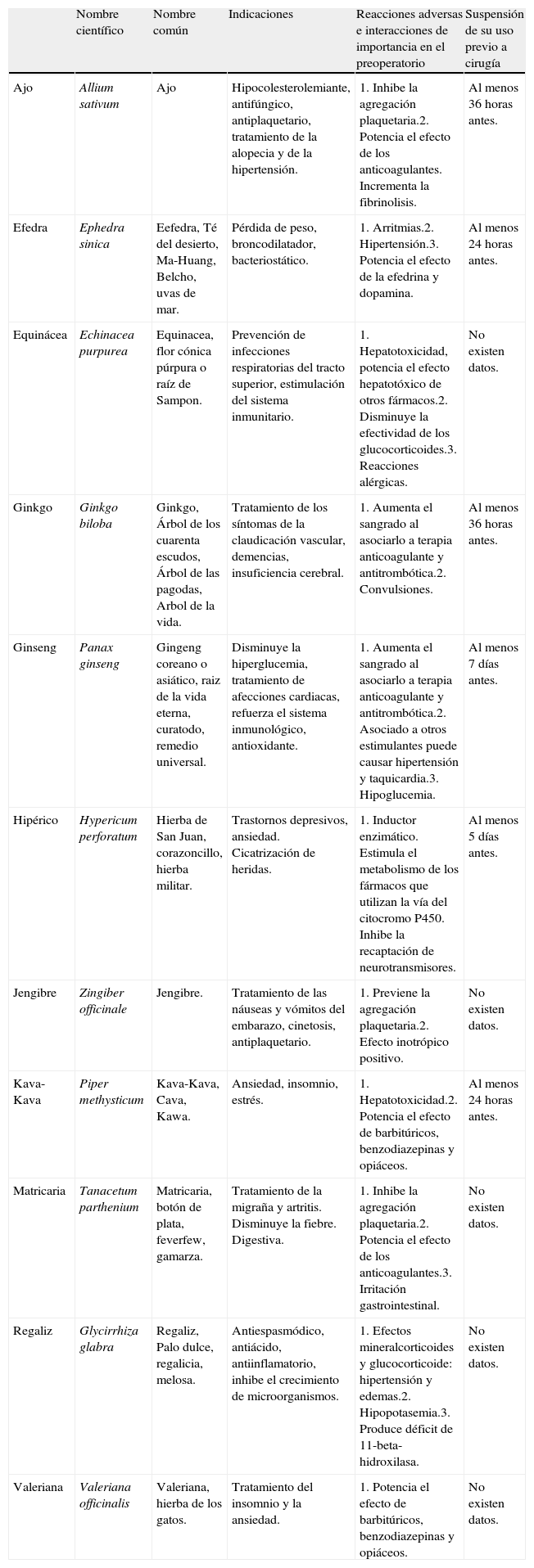Evaluar el grado de conocimiento de los médicos sobre el riesgo perioperatorio de pacientes que consumen plantas medicinales. Revisar las interacciones farmacológicas de las plantas medicinales más relevantes, para justificar un plan de actuación preoperatorio.
Material y métodoSe realizó una encuesta sobre el conocimiento y actitud frente al paciente quirúrgico y consumidor de plantas medicinales, a través de correo electrónico, dirigida a cirujanos y anestesiólogos. Paralelamente, se procedió a la revisión bibliográfica de las propiedades de las especies que pueden interactuar con el proceso anestésico-quirúrgico: Allium sativum, Efedra sinica, Echinacea purpurea, Ginkgo biloba, Panax ginseng, Hypericum perforatum, Piper methysticum, Glycirrhiza glabra y Valeriana officinalis, sus indicaciones e interacciones farmacológicas.
ResultadosLa encuesta fue remitida a 131 facultativos y obtuvo una participación del 80,5%. La procedencia formativa de los mismos fue de 22 centros nacionales y 3 internacionales. El 55% de los encuestados cree en la eficacia de las plantas medicinales pero el 78% no pregunta a los pacientes sobre su consumo. Sólo el 3% de los encuestados conoce las interacciones de alguna de las plantas evaluadas y únicamente el 7% indicaría la suspensión de algunas de ellas previa a la cirugía.
ConclusiónEl consumo de plantas medicinales es una realidad en aumento en nuestra sociedad. Pese a las sugerencias auspiciadas por organismos científicos como la American Society of Anesthesiology sobre los plazos de suspensión temporal del consumo de plantas medicinales previo a intervención quirúrgica, nuestros resultados avalan el incumplimiento, así como un preocupante desconocimiento sobre sus indicaciones e interacciones, por parte de los facultativos médicos.
To assess physicians' knowledge of peri-operative risk for patients who consume medicinal plants. To review interactions between drugs and the main medicinal plants with a view to justifying a plan for preoperative intervention.
Material and methodsSurgeons and anesthesiologists were sent an e-mail survey with questions on knowledge of and attitudes toward surgical patients' consumption of medicinal plants. At the same time, we performed a literature search on the species of plants that can interact with anesthetic and surgical processes. The species included were Allium sativum, Ephedra sinica, Echinacea purpurea, Ginkgo biloba, Panax ginseng, Hypericum perforatum, Piper methysticum, Glycyrrhiza glabra and Valeriana officinalis. The focus of the search was on indications for the use of these plants and their interactions with drugs.
ResultsThe questionnaire was sent to 131 physicians. The response rate was 80.5%. Twenty-two physicians had trained in Spanish hospitals and 3 in hospitals abroad. Medicinal plants were believed to be effective by 55%, but 78% did not ask patients about their use. Only 3% knew the interactions of some of the plants mentioned in the survey and only 7% knew that the use of some should be suspended before surgery.
ConclusionsMedicinal plants are currently being used in our culture. In spite of appropriate warnings from such scientific bodies as the American Society of Anesthesiologists on timing the withdrawal of medicinal plants before surgery, our results indicate that the advice is not followed. We also found that physicians lacked knowledge of the indications for using these plants and their interactions, a situation which is alarming.
Artículo
Comprando el artículo el PDF del mismo podrá ser descargado
Precio 19,34 €
Comprar ahora










